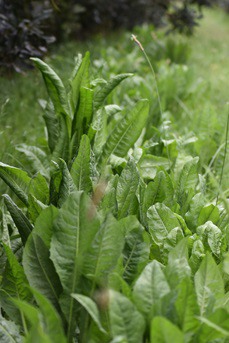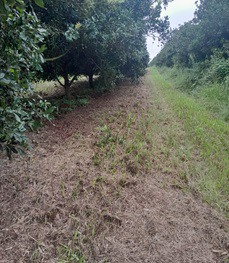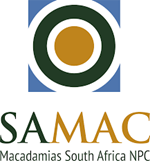Free market principles reign in the macadamia orchards on Roodewal Farm, outside Nelspruit, whose crops include macadamia, citrus and avocado with 150ha of wild or conservation area besides.
“The same revolution around gut biology that is playing out in medicine is rolling in agriculture. In some ways it’s the same revolution: harnessing the contemporary understanding of microbiology in the gut and the soil. We are what we eat and the food we eat spends more time connected to the soil than the supermarket,” says Michael Parker, macadamia production manager at Roodewal.
 Farmers in South Africa’s Lowveld are seeing the value of harvesting biologically rich carbon from substorey plants within the orchard.
Farmers in South Africa’s Lowveld are seeing the value of harvesting biologically rich carbon from substorey plants within the orchard.
At Roodewal, inter rows are sown with oats, buffalo and Rhodes grass, plantago, Ageratum, chicory (right), lucerne and clover. Just before harvest it is mown and blown under the canopy, leaving pickers with a flat mat of mulch from which to gather.
Orchards with a variety of substorey plants attract a broader ecosystem, Parker explains, creating an attractive habitat for pest predators and feeding pollinators. These are free value adding communities although establishing and maintaining the habitats does have a cost.
“Nature is replete with systems and to some extent we need to learn to work with and harness those systems rather than fight them. There is a place for the fight but as our understanding of biological systems grows, so grows our ability to work with them and thus increase our yields and reduce our synthetic inputs.”
Michael Parker assessing the depth of the spongy layer and its inhabitants
Farming the full hectare
Parker remarks: “It’s mid-January, to date the season has been blessed with enough ducks in a row for the nut set still to be looking good. The bees could take their time and neither the heat nor rain has been destructive.”
The new harvest (by hand) is in two months.
In a spongy layer under the leaf litter white mycelium strands are in evidence in the Roodewal orchards. Parker would like to see the sponginess extend even deeper, but Dr Schalk Schoeman, entomologist and macadamia adviser at the South African Macadamia Growers’ Association, assures him that it’s more than many growers have. “In agriculture over the last hundred years inputs per hectare have climbed and profits per hectare have declined. Two graphs going in wrong directions, so farmers are generally becoming less bankable,” Parker points out.
“In agriculture over the last hundred years inputs per hectare have climbed and profits per hectare have declined. Two graphs going in wrong directions, so farmers are generally becoming less bankable,” Parker points out.
Right: interrow vegetation is mown before harvest
His intent is increasing soil carbon - not resulting from any “climate hysteria”, he says, but based on an Australian bank’s actuarial analysis of farming enterprises which showed up a surprising constant amongst the most bankable farmers: “The higher the carbon, the greater the long term prediction of their success. Soil carbon as a factor trumped management, marketing, financial skills and all the other important metrics in the study.”
New Zealand farmer Doug Avery has also influenced his thinking on how to farm the full hectare and retain water in the soil, through, for example, the deep roots of lucerne.
Insect life in a healthy orchard
Dr Schoeman approvingly remarks on the insect life heard in the orchard – apart from a turaco rasping nearby. “That’s the stuff that sparks my imagination,” he says, pointing out syrphid wasps and pompilid wasps, often around blackjacks (Bidens pilosa). “A complex orchard is not unlike the Kruger National Park.”
Duiker antelope droppings and a centipede beside a Roodewal macadamia orchard
During early summer farmers still have a lot of ‘wiggle room’, Dr Schoeman says. “As you move towards late November your wiggle room becomes very small. And I wouldn’t really wiggle at all after that.”
Dr Schoeman continues: “If I managed a farm, and I saw stink bugs during early November, I wouldn’t necessarily pull out all the spray carts. This is not how all farmers see it, but I’d make a decision around which species were around in the orchard and how many.”Parker concurs: for a period of two weeks during the previous season they didn’t scout, he says, and that took them over the threshold of 0.4% stinkbug damage.
Right: re-introducing indigenous and endemic plants to orchards
He adds that nutborer moths, in the same Thaumatotibia genus as false codling moth, have been very aggressive this season.
Getting the most out of fewer chemical applications
Spraying frequency depends on, inter alia, whether it’s an early variety, like Nelmak, on which one can (all things being equal) skip a second pyrethroid spray, Parker explains. The much-planted Beaumont variety is later and generally requires at least one more spray against stink bugs during the season.
“The best we’ve got away with is four times over a whole season. The most was probably twice that. Chemicals need to be rotated, some are removed from the market, new ones enter. It’s a moving carpet dance.”
Scouting: sine qua non in a productive orchard
Growers have been paying more attention to the calibration of spray machines and to the pH when they prepare stinkbug spray mixes than before. “pH is very important and the wrong pH [within a crop protection mixture] can literally mean the product degrades on its way to the orchard,” Dr Schoeman explains.
Pruning has definitely helped, they both agree. It opens the canopy to receive chemicals and creates windows for penetration of sunlight; 90%+ of Mpumalanga macadamia orchards are pruned these days.
“There is a direct correlation between pruning and the number of sprays required. At the Agricultural Research Council there is a wagon wheel density planting and the correlation between density and damage was approximately 92%,” he adds.
Michael Parker and Dr Schalk Schoeman talking about the biodiversity possible within a macadamia orchard
Scale and the macadamia felted coccid killing trees
Many Mpumalanga Lowveld farms are experiencing a scale insect infestation at the moment; in fact, Dr Schoeman remarks there are very few farms without it; Roodewal is one of the few.
He remarks that scale insects and the macadamia felted coccid are killing trees.
“It’s terrible. Trees are drying. You see it’s difficult to get the spray mixture to the main stem and it’s impossible in an unpruned orchard. We need researchers in the orchards every day. Only then will we move forward.” South African Macadamia Growers’ Association
South African Macadamia Growers’ Association
Tel: +27 12 001 4107
Email: [email protected]
https://samac.org.za/
